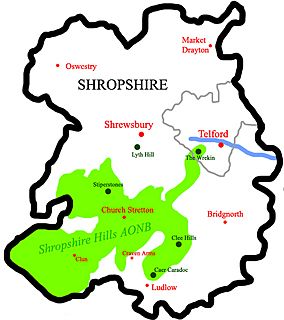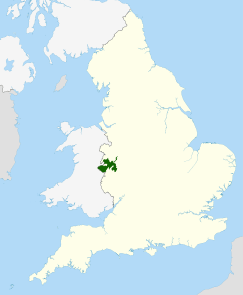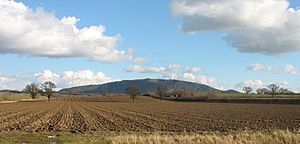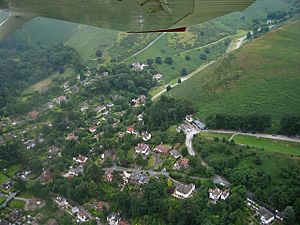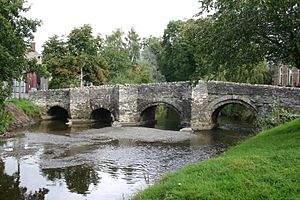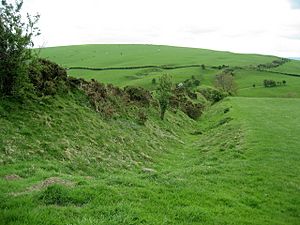Shropshire Hills AONB facts for kids
The Shropshire Hills are a special natural area in Shropshire, England. They are so beautiful and important that they have a special title: an Area of Outstanding Natural Beauty (AONB). This amazing place is in the south of Shropshire, right next to the border with Wales. It became an AONB in 1958 and covers about 802 square kilometers (310 square miles) of land, mostly in the southwest of Shropshire. It's named after the many hills found there. Main roads and railway lines, like the A49 road and the Welsh Marches Line, run through the area from north to south. They pass by towns such as Shrewsbury, Church Stretton, Craven Arms, and Ludlow.
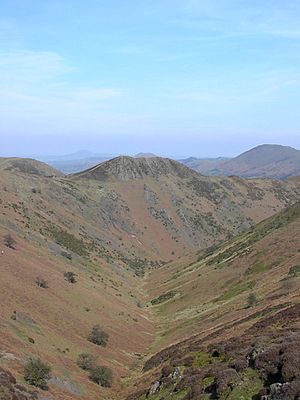
Contents
Amazing Hills of Shropshire
The Shropshire Hills are part of the Welsh Marches, which is the border area between England and Wales. These hills are quite tall. The highest point in Shropshire is Brown Clee Hill, near Ludlow, which is 540 meters (1,772 feet) high. This makes Shropshire's highest hill the 13th tallest among English counties.
Titterstone Clee Hill, part of the Clee Hills, is almost as high as Brown Clee. It stands at 533 meters (1,749 feet) and is the third highest hill in the county. The Stiperstones are the second highest, at 536 meters (1,759 feet). They are famous for their unique rock formations called tors, made of quartzite. Two well-known tors are Devil's Chair and Shepherd's Rock.
Popular Hills to Explore
The Long Mynd is a very popular and easy-to-reach hill. It covers a large area of 22 square kilometers (5,436 acres). Its highest point is Pole Bank, at 516 meters (1,693 feet). The Long Mynd is close to Church Stretton.
It includes a beautiful spot called Carding Mill Valley. This valley is a popular place for visitors. It was made into a "honeypot" area to attract tourists. This helps protect the more sensitive parts of the Long Mynd from too many visitors.
One of the most famous hills is Caer Caradoc, which is 459 meters (1,506 feet) high. It is right next to the village of All Stretton. The Wrekin is another very popular hill, standing at 407 meters (1,335 feet). It has a well-used walking trail. The Wrekin is in the far northeastern part of the AONB, near Wellington. It's easy to get to because it's close to major towns and main roads like the A5 and M54. Ercall Hill, known for its interesting geology, is just north of The Wrekin.
Another important hill is Corndon Hill. Its very top is actually in Wales.
Towns and Villages in the AONB
The biggest town within the Shropshire Hills AONB is Church Stretton. It has about 3,000 people and is sometimes called "Little Switzerland" because of its beautiful scenery. The only other town completely inside the AONB is Clun, which has fewer than 1,000 people and is located in the Clun Valley.
Ludlow, the largest town in South Shropshire, is just south of the AONB. The team that manages the Shropshire Hills AONB is based in Craven Arms, which is also just outside the main protected area. Bishop's Castle is a small town with about 1,500 people, located near the Welsh border to the west. Bucknell is a notable village in the south of the area. While Knighton is in Wales, its train station is actually within the Shropshire Hills AONB.
Rivers Flowing Through the Hills
Several rivers flow through or near the Shropshire Hills AONB:
- River Clun – This river starts near Anchor and eventually joins the River Teme.
- Cound Brook – This brook begins from smaller streams flowing off the Long Mynd and Caer Caradoc. It then flows into the River Severn.
- River Teme – This river flows through Knighton and Bucknell, then past Ludlow, before continuing into Herefordshire.
- River Rea – This river flows from north to south and passes through Cleobury Mortimer.
Historical Places to Visit
There are many interesting historical sites in or near the Shropshire Hills AONB:
- Stokesay Castle – Located near Craven Arms, this is a very well-preserved fortified manor house from the past.
- Ludlow Castle – This castle in Ludlow was built in the 11th century. It was a strong fortress for one of the Marcher Lords, Roger de Lacy, who protected the border with Wales.
- Offa's Dyke – This is a huge, ancient earth wall that runs through the area, including across the Clun Valley. It was built a very long time ago to mark a border.
- Clun Castle – This castle is located near the town of Clun.
Amazing Wildlife
The Shropshire Hills are home to many different kinds of animals and birds. Here are some of the fascinating creatures you might spot:
- Peregrine falcon – A very fast bird of prey.
- Dipper – A bird that can walk underwater in rivers.
- Ring ouzel – A type of thrush found in hilly areas.
- Merlin – A small, swift falcon.
- Curlew – A large wading bird with a long, curved beak.
- Tree sparrow – A small bird often found near farms and woodlands.
- Pied flycatcher – A bird that catches insects in flight.
- Barn owl – A beautiful owl known for its heart-shaped face.
- Red fox – A common and clever mammal.
- Badger – A nocturnal animal that lives in burrows called setts.
- Red grouse – A game bird found in heather moorlands.
- Turtle dove – A gentle, migratory bird.
- Buzzard – A common bird of prey often seen circling high in the sky.
- Common snipe – A wading bird with a long bill, known for its zigzag flight.
- Northern lapwing – A distinctive bird with a crest, often found in open fields.
- Common redshank – A wading bird with bright red legs.
Other Fun Places to Visit
- Clun Forest – This is a wild and remote area with lots of woodland and hills, great for exploring.
- Wyre Forest – A very large forest. Half of it is in Shropshire, and the other half is in Worcestershire.


